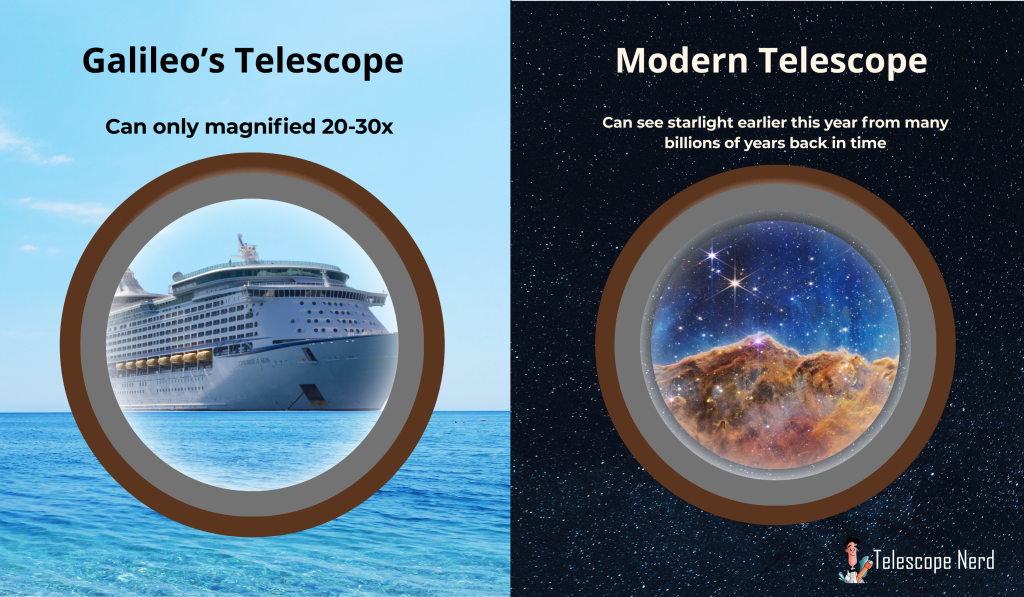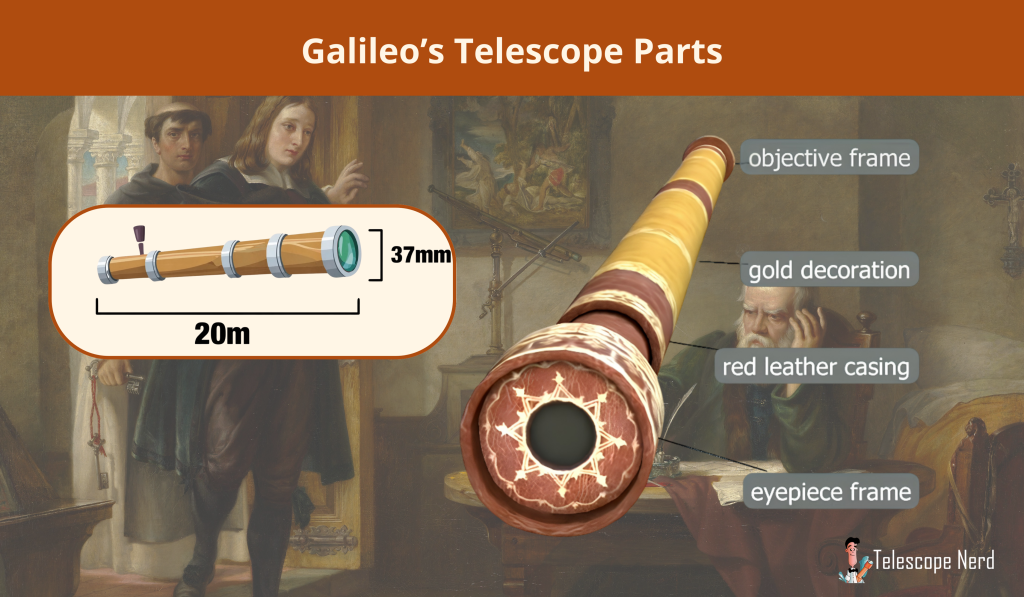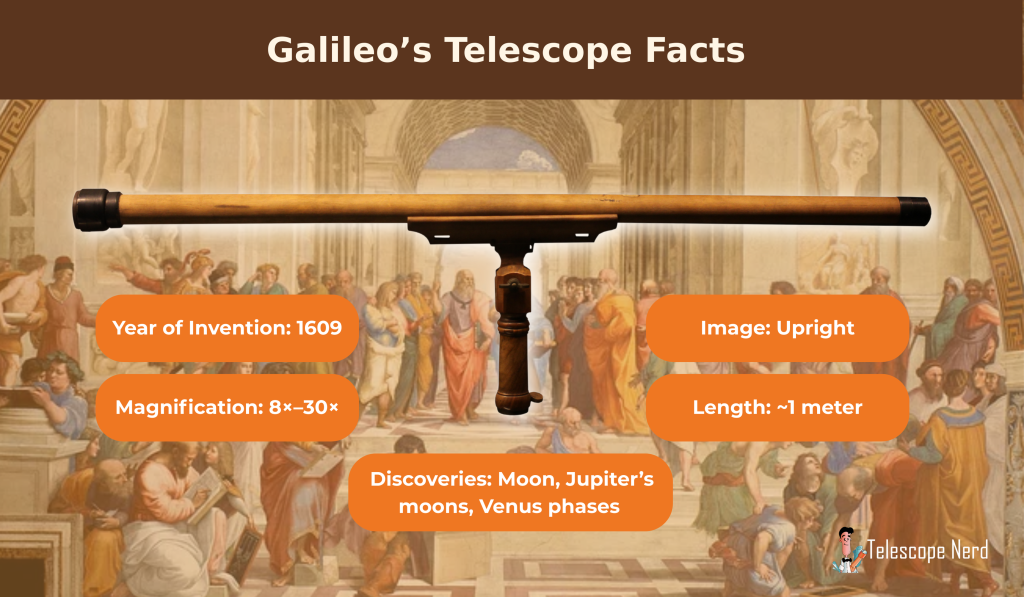Galileo Galilei Telescope: How it Works, Discoveries
The Galileo Galilei telescope, known as the Galilean refractor, is a pioneering instrument in astronomy. Galileo did not invent the telescope but significantly improved its design after hearing about the “Dutch perspective glasses” in 1609.
Galileo Galilei telescope consisted of a main tube with separate housings for the objective and eyepiece lenses. Galilean telescope used a simple arrangement of lenses to magnify objects, similar to a pair of opera glasses. Galileo’s initial telescope magnified objects 3x, which he later refined to 20x. The original Galileo telescope had a 20-30 power magnification, featuring a 37 mm objective lens and a 13 mm eyepiece.
Galileo’s telescope worked by using a combination of two lenses: a large converging lens (objective) and a smaller diverging lens (eyepiece). This configuration allowed for a magnified and upright image, enabling significant astronomical observations and discoveries.
The objective lens in Galileo’s telescope was convex, with a diameter of about 37 mm and a focal length of around 980 mm. Light from the observed object passed through the objective lens, which converged the light and brought it to a focus, forming a real, inverted image. The eyepiece lens was concave, with a diameter of about 22 mm and a focal length of around 160 mm. The eyepiece lens then diverged the light, magnifying the real image and creating a virtual, upright image for the observer.
Galileo’s early telescopes had low magnification, ranging from 3x to around 30x, but he continued to refine his design and eventually achieved up to 21x magnification. Increased magnification allowed Galileo to make significant astronomical discoveries, such as observing Jupiter’s moons, the phases of Venus, and the mountains and craters on the Moon.
What is Galileo Galilei telescope?
The Galileo Galilei telescope, often referred to as the Galilean refractor, is a pioneering instrument in the field of astronomy. Italian scientist and polymath Galileo Galilei did not invent the first telescope but significantly improved design of an existing telescope. Galileo heard about the “Dutch perspective glasses” in 1609 and was inspired to build his own version of the telescope.
The Galileo Galilei telescope consisted of a main tube with separate housings at either end for the objective and the eyepiece. The tube was formed by two semicircular tubes held together by copper wire and covered with paper. The objective lens was 51 mm in diameter, and the eyepiece was a diverging lens. Galileo’s initial telescope magnified objects 3x, which he later refined to 20x. Galilean telescope used a simple arrangement of lenses to magnify objects, similar to a pair of opera glasses.
Galileo’s telescope was a significant improvement over earlier designs, allowing for more precise and detailed observations of celestial bodies. The original Galileo telescope had a 20-30 power magnification, featuring a 37 mm objective lens and a 13 mm eyepiece. This invention marked a major milestone in the history of astronomy, paving the way for future discoveries and a deeper understanding of the universe.
A replica of the Galileo Galilei telescope is on display at the Museo Galileo in Florence, Italy. This replica, labeled “Galileo’s Telescope,” provides a detailed description of its construction and functionality. The design of Galileo’s refractor telescope has inspired many variations, including the Dobsonian telescope, a type of reflecting telescope known for its simplicity and affordability. This telescope, often referred to as a “Dob,” has made significant contributions to both astro and terrestrial observations.

Was Galileo’s telescope the first invented telescope?
No, Galileo’s telescope was not the first invented telescope, despite the common misconception. The honor of creating the oldest known telescope goes to Hans Lippershey. Lippershey applied for a patent for his invention in the year 1608, marking the date of the first known telescope.
Galileo’s contributions to the development and use of the telescope are significant. Galileo Galilei built his own improved refracting telescope in 1609, just a year after Lippershey’s patent. Galileo designed and created a stronger type of telescope, improving upon the initial design. With his telescopes, Galileo made important astronomical observations. Galileo was the first to use the telescope for significant celestial studies, making groundbreaking discoveries about the Moon, the moons of Jupiter, and other celestial bodies. These discoveries had a profound impact on our understanding of the universe.
What type is Galilean telescope?
The Galilean telescope is a type of refracting telescope. This telescope was first designed and perfected by the renowned Italian physicist, Galileo Galilei, in the early 17th century.
The Galilean telescope operates on a simple yet effective principle. It uses a convex objective lens, which is a lens that bulges outwards, to gather and focus light from distant objects. This lens is positioned at the front end of the telescope. The light collected by the objective lens is then directed towards a concave eyepiece, a lens that curves inwards, situated at the other end of the telescope. Combination of lenses allows the Galilean telescope to produce an erect and magnified image of the observed object.
One of the distinctive features of the Galilean telescope is its ability to produce an upright image. This characteristic makes it particularly suitable for day-time use and terrestrial observations. Galilean telescope has a narrow field of view compared to other types of telescopes. This means that it can only capture a relatively small area of the sky at any given time.
How powerful was Galileo’s telescope?
The Galileo’s telescope had a significant magnification power, allowing Galileo to make several groundbreaking observations. The first version of Galileo’s telescope, completed in 1609, had a magnification power of 8-9 times. Galileo continued to refine his telescope design, eventually achieving a magnification power of 20x.
The most powerful versions of Galileo’s telescopes had magnifications up to 30x. This was a significant achievement at the time, as most telescopes in the early 17th century had a magnification power of around 10x to 20x. Galileo’s telescope had a simple refracting design, consisting of a convex objective lens and a concave eyepiece. The objective lens had a diameter of 37 mm and a focal length of 1,400 mm, giving the telescope a strong magnifying power.
Despite Galilean telescope limitations, such as a narrow field of view, Galileo’s telescope was a powerful tool that allowed him to make several important discoveries. Galileo used his telescope to observe the moon, planets, and stars, discovering four moons orbiting Jupiter and observing the phases of Venus. These observations provided evidence for the Copernican heliocentric model, which placed the sun at the center of the universe.
How did Galileo’s telescope work?
Galileo’s telescope, known as a Galilean telescope, worked by using a combination of two lenses: a large converging lens (objective) and a smaller diverging lens (eyepiece). This configuration allowed for a magnified and upright image, enabling significant astronomical observations and discoveries.
The objective lens in Galileo’s telescope was convex, with a diameter of about 37 mm (1.5 inches) and a focal length of around 980 mm (38.6 inches). Light from the observed object passed through the objective lens, which converged the light and brought it to a focus, forming a real, inverted image. The eyepiece lens, on the other hand, was concave, with a diameter of about 22 mm (0.9 inches) and a focal length of around 160 mm (6.3 inches). The eyepiece lens then diverged the light, magnifying the real image and creating a virtual, upright image for the observer.
Galileo’s early telescopes had low magnification, ranging from 3x to around 30x. However, Galileo continued to refine his design and eventually achieved up to 21x magnification. This increased magnification allowed Galileo to make significant astronomical discoveries, such as observing Jupiter’s moons, the phases of Venus, and the mountains and craters on the Moon.

What parts did Galileo’s telescope have?
The telescope was a refracting type, consisting of three main parts: the objective lens, the eyepiece lens, and the tube.
The objective lens, known as the objective, was a convex lens with a diameter of approximately 37 mm (1.5 inches) and a focal length of about 1.4 meters (4.6 feet). This lens was responsible for collecting light from distant objects and focusing it. The eyepiece lens, or the ocular, was a concave lens with a diameter of around 13 mm (0.5 inches). Its primary function was to magnify the focused light from the objective lens, allowing Galileo to observe celestial objects more closely.
The tube, a wooden structure approximately 1.2 meters (3.9 feet) long and 3.8 cm (1.5 inches) in diameter, held the objective and eyepiece lenses in place. It maintained the correct distance and alignment between the lenses, ensuring the telescope’s functionality.
Did Galilean telescope have an eyepiece?
Yes, the Galilean telescope had an eyepiece. This eyepiece was a smaller concave lens, an integral part of the telescope’s design. The Galilean telescope consisted of two main parts: a large convex objective lens and a smaller concave eyepiece lens. The objective lens collected light from distant objects and formed a real, inverted image. This image was then magnified by the eyepiece lens, resulting in a larger image for the observer. The concave shape of the eyepiece lens ensured that the magnified image appeared upright, a unique feature of the Galilean design.
Galileo’s original telescope had a 37mm diameter plano-convex objective lens with a focal length of 980mm. Although the original eyepiece was lost, it is believed to have been a plano-concave lens. Modern replicas often use a biconvex lens as the eyepiece, but the original design used a concave lens to achieve the desired magnification and image orientation. The Galilean telescope is often compared to the Keplerian telescope, with the main difference being the use of a convex eyepiece lens in the Keplerian design.
What is the difference of Galilean vs Keplerian telescope?
One of the major differences between the Galilean and Keplerian telescopes is the orientation of the image that they produce. The Galilean telescope produces an upright image, which makes it well-suited for terrestrial observations. On the other hand, the Keplerian telescope produces an inverted image, which is not a problem for astronomical observations but can be disorienting for observing things on Earth.
Another key difference between the two types of telescopes is their field of view. The Galilean telescope has a narrow field of view, which can make it difficult to locate objects in space. In contrast, the Keplerian telescope has a larger field of view, making it easier to observe a wider area of the sky.
Keplerian telescope is considered superior to the Galilean telescope in image quality. The Galilean telescope is affected by spherical aberration, which can distort the image and make it less clear. The Keplerian telescope produces a clearer image with less distortion.
Galilean telescope is better suited for terrestrial observations, while the Keplerian telescope is more suitable for astronomical observations. The Galilean telescope is not well-suited for high magnifications, which can make it difficult to observe distant objects in detail. The Keplerian telescope, on the other hand, is better suited for high magnifications, making it ideal for observing distant celestial objects.
What was discovered by Galileo Galilei’s telescope?
One of the most significant discoveries made by Galileo using his telescope was the identification of the four largest moons of Jupiter, now known as the Galilean moons: Io, Europa, Ganymede, and Callisto. This observation was a pivotal moment in astronomy, as it was the first time that a celestial body was seen to have its own orbiting satellites.
Galileo’s observations gave evidence for the Copernican model, which proposed that the planets orbit the sun. Galileo did this by describing the phases of Venus, which demonstrated that Venus orbits the sun, not the Earth. This was a significant blow to the geocentric model, which had been widely accepted until that time.
Using Galilean telescope, Galileo was able to study the appearance of the moon in unprecedented detail. Galileo documented its mountainous and cratered surface, contrary to the popular belief that the moon was a smooth sphere. This was one of the first times that an astronomer had been able to accurately describe the moon’s surface.
Galileo’s observations told us that the Milky Way is not just a uniform band of light in the sky, but is actually composed of numerous stars scattered at different distances. This was a groundbreaking discovery, as it challenged the traditional view of the Milky Way as a celestial sphere.
Lastly, Galileo was the first to observe the rings of Saturn, although he initially mistook them for handles or moons on either side of the planet. Despite this initial misunderstanding, his observation was an important step towards understanding the true nature of Saturn’s rings.
Did Galilean telescope lead to scientific revolution?
Yes, the Galilean telescope led to a scientific revolution. Galileo’s systematic use of the telescope for astronomical observations resulted in groundbreaking discoveries that provided crucial evidence supporting the heliocentric model and challenging the prevailing geocentric views.
Galileo’s observations led to remarkable discoveries, including the moons of Jupiter, the phases of Venus, and the rough surface of the Moon. These discoveries were significant contributions to the world of astronomy and provided strong evidence for the Copernican heliocentric model, which placed the Sun at the center of the solar system. This was in direct contradiction to the geocentric model supported by Aristotle and Ptolemy.
Galileo’s observations had a profound impact on the scientific method and led to a paradigm shift in cosmology. Galileo’s work challenged the authority of the Catholic Church and the Aristotelian view of the universe, paving the way for a more empirical and evidence-based approach to science. The use of the telescope demonstrated the importance of experimentation, observation, and measurement in scientific inquiry. This revolutionary approach laid the foundation for the scientific method and contributed to a significant shift in our understanding of the cosmos. The telescope, improved by Galileo, revolutionized the way scientists observed and made discoveries about the world, forever changing the course of astronomical research.
Where is original Galilean telescope now?
The original Galilean telescope is currently housed at the Museo Galileo, a prestigious institution that celebrates the life and work of the great Italian astronomer, Galileo Galilei. Known as the Galileo Museum, this esteemed establishment is located in the heart of Florence, Italy, a city renowned for its rich history and cultural significance.
Galileo Galilei crafted two surviving telescopes that have stood the test of time. These two instruments are now part of the Museo Galileo’s extensive collection. They serve as a testament to Galileo’s ingenuity and his relentless pursuit of knowledge, offering visitors a unique glimpse into the past.
Does replica of Galilean telescope exist?
Yes, replicas of the Galilean telescope exist, meticulously crafted based on Galileo’s original design and detailed descriptions. These replicas provide an accurate picture of the historic instrument that revolutionized our understanding of the cosmos. The construction of these replicas often involves careful study of Galileo’s records, including diagrams and labeled drawings, to ensure their authenticity.
One of the most notable replicas can be found in the Museo Galileo in Florence, Italy. This replica, a refracting telescope with a 37-mm objective lens and a 725-mm focal length, is a faithful reconstruction of Galileo’s original telescope. The Museo Galileo’s replica is not the only one; other institutions around the world keep replicas of this significant instrument. National Air and Space Museum in Washington, D.C., and the Deutsches Museum in Munich, Germany, both have replicas on display, offering visitors a chance to look at a piece of history.
These replicas serve multiple purposes beyond being mere display items. Galilean telescope replicas are valuable tools for research, providing insights into the workings and capabilities of Galileo’s telescope. Replicas are used for educational purposes, helping students and enthusiasts understand the design and function of the telescope that Galileo used to make his groundbreaking discoveries.
What are facts about Galileo’s telescope?
The first Galilean telescope had a convex objective lens and a concave eyepiece, which allowed it to magnify objects three times their original size. Later, Galileo developed a more powerful telescope with a convex objective lens and a convex eyepiece, capable of magnifying objects up to 33 times.
Galileo’s telescope was a refracting telescope, which uses a lens to focus light and form an image. The telescope had a tube that was 60 cm (24 inches) long and 3.8 cm (1.5 inches) in diameter. With Galilean telescope, Galileo could observe the night sky with unprecedented clarity, making the first recorded telescopic observations of the heavens on January 7, 1610.

Galileo observed the Moon’s surface with his telescope and found it to be mountainous and not a perfect sphere, as was previously believed. Galileo discovered the four largest moons of Jupiter (Io, Europa, Ganymede, and Callisto), which he named the Medicean stars. Galileo observed the phases of Venus, which provided evidence for the Copernican heliocentric model. Galileo’s discovery of sunspots helped to disprove the Aristotelian geocentric model.
Galileo published his findings in a small book called “Sidereus Nuncius” (Starry Messenger) in 1610. In this book, Galileo included detailed diagrams of his telescope and observations, providing valuable information for other astronomers. Galileo’s telescope and observations revolutionized astronomy, turning it towards a more scientific and observational approach. This change paved the way for future astronomers, such as Johannes Kepler and Isaac Newton, to make further discoveries about the universe.

